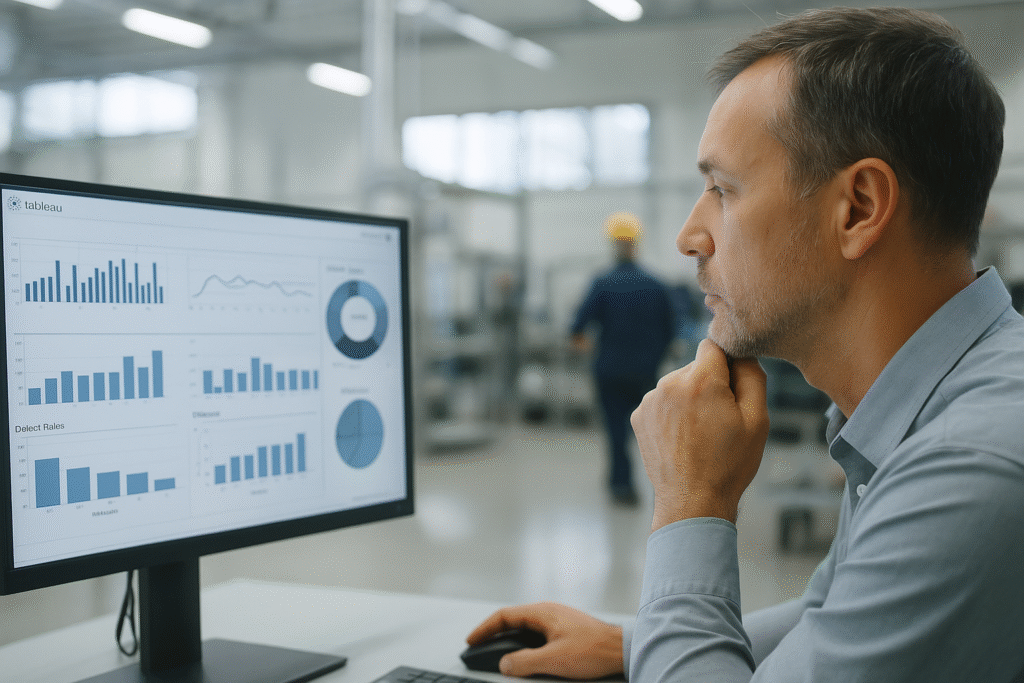
For decades, lean manufacturing has been the gold standard for reducing waste, streamlining operations, and improving productivity. From automotive plants to textile factories, the principles of 5S, Kaizen, Kanban, and PDCA reshaped how industries think about efficiency.
But today, U.S. manufacturers face an entirely new reality. Global competition, supply chain disruptions, rising costs, and rapid technology shifts have pushed traditional lean systems to their limits. Lean is still powerful, but on its own, it’s no longer enough to keep pace with modern challenges.
The future of manufacturing lies in data-driven lean systems a fusion of time-tested lean practices with the power of data analytics, AI, and IoT technologies.
Why Traditional Lean Isn’t Enough Anymore
While lean has helped companies cut costs and reduce waste, many factories still struggle with:
- Procurement delays and supplier unreliability
- Bottlenecks caused by poor demand forecasting
- Excess inventory or stockouts due to inaccurate planning
- Lack of real-time visibility into operations
According to a report by Deloitte, 62% of U.S. manufacturers cite supply chain visibility as their biggest challenge. Even companies practicing lean often lose money due to inefficiencies that can’t be solved without deeper data insights.
The Rise of Data-Driven Lean Manufacturing
Imagine a factory where:
- Procurement costs are forecast with 95% accuracy
- Supplier reliability is scored in real time using predictive analytics
- IoT sensors detect potential bottlenecks before they cause delays
- Managers make faster, smarter decisions with dynamic dashboards
This isn’t science fiction it’s the reality that companies like LeanTex Solutions are building. By combining Python, SQL, Tableau dashboards, and IoT sensors, manufacturers can go beyond gut instinct and make data-backed decisions at every step.
Instead of simply reacting to problems, data-driven lean allows companies to anticipate them before they occur.
Real-World Applications
At LeanTex, we’ve seen firsthand how data analytics transforms lean practices:
- Procurement Savings: Predictive dashboards help manufacturers cut procurement costs by 10–15%, freeing up capital for growth.
- Supplier Reliability: Data scoring models ensure companies partner with the most reliable vendors, reducing disruptions.
- Workflow Optimization: Simulations of lean systems allow managers to test process changes virtually before implementing them.
- Inventory Accuracy: Predictive modeling reduces both overstocking and shortages, improving cash flow and customer satisfaction.
One pilot study with small-to-mid-size textile factories in Texas demonstrated a 10% reduction in procurement costs and significant throughput improvements, validating the model.
Beyond Efficiency: Strategic Advantages
The benefits of data-driven lean go far beyond cost savings:
1. Reshoring U.S. Manufacturing
By reducing costs and improving efficiency, U.S. factories can compete with overseas production, supporting America’s reshoring initiatives.
2. Workforce Upskilling
Modern factories need workers who can interpret dashboards, manage IoT-enabled systems, and apply data analytics. LeanTex Solutions is already planning workforce training programs to bridge this skills gap.
3. Sustainability
Lean has always reduced waste but when combined with analytics, it also helps cut energy use, optimize resource allocation, and support eco-friendly production.
4. Risk Management
Data analytics allows companies to prepare for supply chain disruptions, equipment failures, or unexpected demand spikes, making industries more resilient.
The Role of AI and IoT in the Lean Transformation
- AI (Artificial Intelligence) is now being used to optimize scheduling, predict equipment failures, and balance resource allocation in real time.
- IoT (Internet of Things) sensors give managers a live feed of machine performance, energy consumption, and inventory levels.
- Predictive Maintenance, powered by IoT and AI, reduces downtime by forecasting failures before they happen, extending machine lifespan and lowering repair costs.
This integration of AI and IoT with lean practices creates the foundation of the “smart factory” a system that is lean, intelligent, and continuously improving.
Challenges to Adoption
Transitioning to data-driven lean systems isn’t without hurdles:
- Initial investment costs in technology and training
- Resistance to change from employees used to traditional workflows
- Data management challenges, including cybersecurity and integration with legacy systems
However, companies that overcome these challenges gain a long-term competitive edge. Those that don’t risk falling behind in a global market that is rapidly digitizing.
Looking Ahead: The Next 5 Years
By 2028, experts predict that most U.S. manufacturers will have integrated data-driven lean platforms into their operations, and LeanTex Solutions is positioning itself to lead that movement. Over the next five years, the company aims to onboard more than 25 factories across the United States, delivering an average of at least 15 percent in cost savings for its clients. Alongside financial impact, LeanTex is committed to job creation, with plans to generate 20 to 25 high-skilled roles in data analytics, supply chain optimization, and lean consulting. Equally important is workforce development: the company is preparing to launch at least three accredited training programs that will equip American workers with the skills needed for the future of smart manufacturing. Together, these milestones not only strengthen LeanTex’s business model but also align with national priorities around supply chain resilience, reshoring, and advanced manufacturing competitiveness.
Conclusion: A Smarter, Leaner Future for U.S. Manufacturing
Lean manufacturing isn’t going away it’s evolving. The combination of lean methodologies with AI, IoT, and data analytics will define the future of U.S. industry.
For manufacturers, the message is clear: those who embrace data-driven lean will lead; those who don’t will fall behind.
At LeanTex Solutions, we are at the forefront of this transformation, helping manufacturers cut costs, strengthen supply chains, and build smarter factories that can thrive in a competitive global economy.
